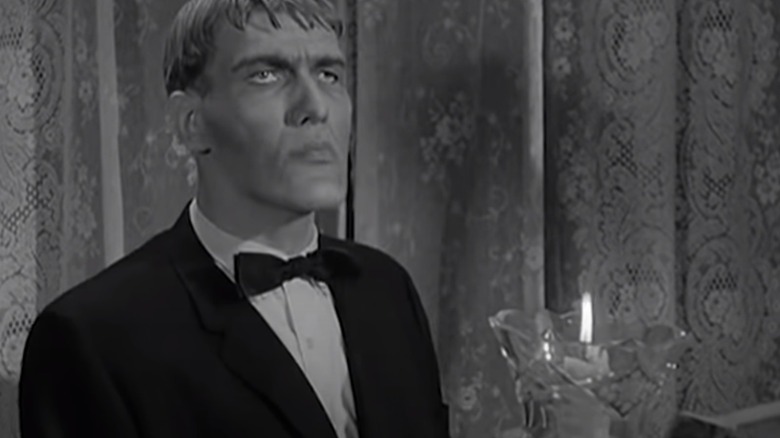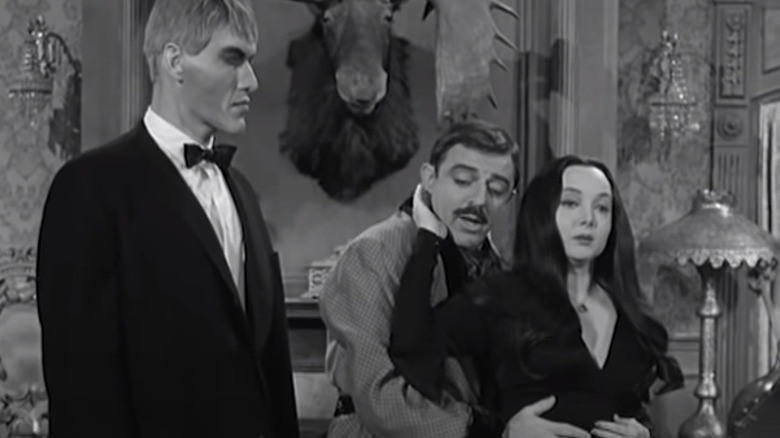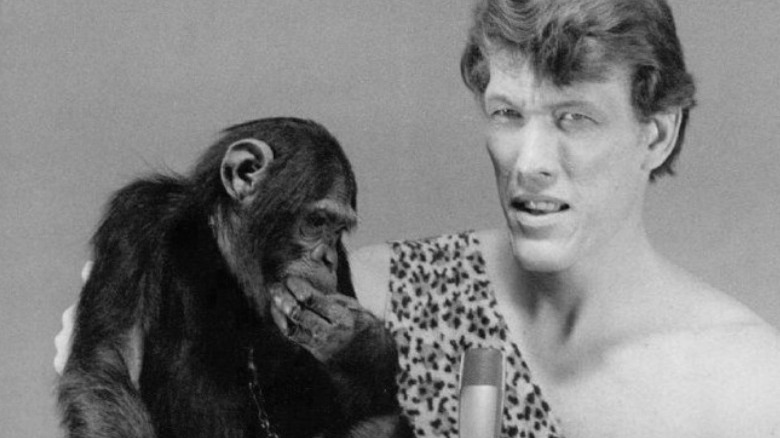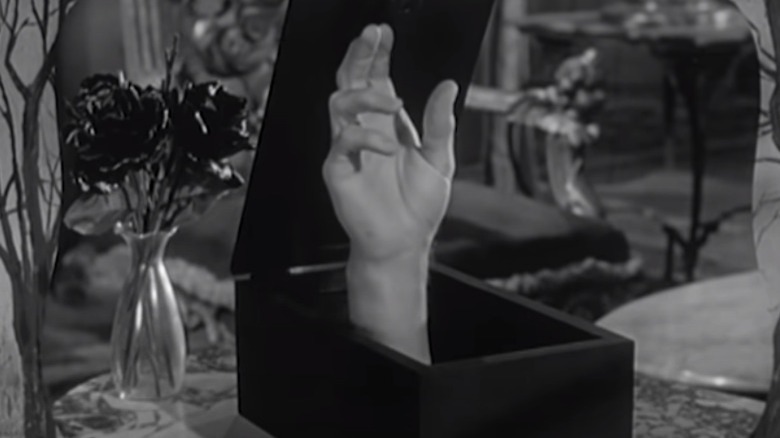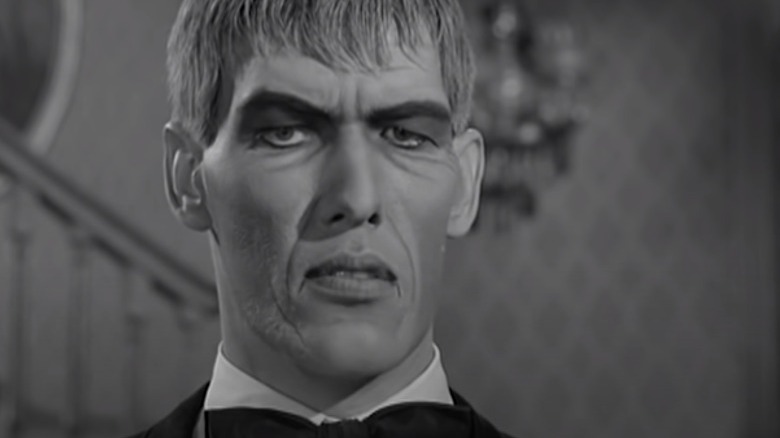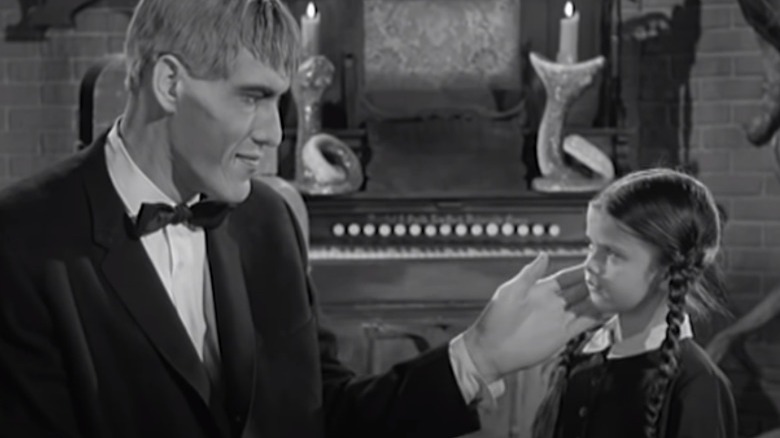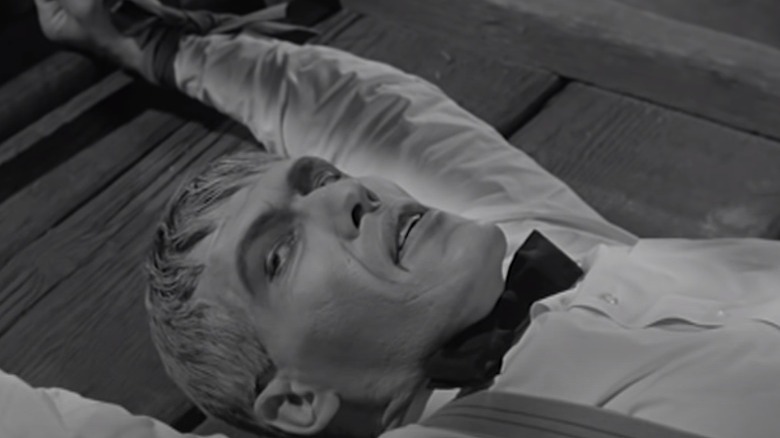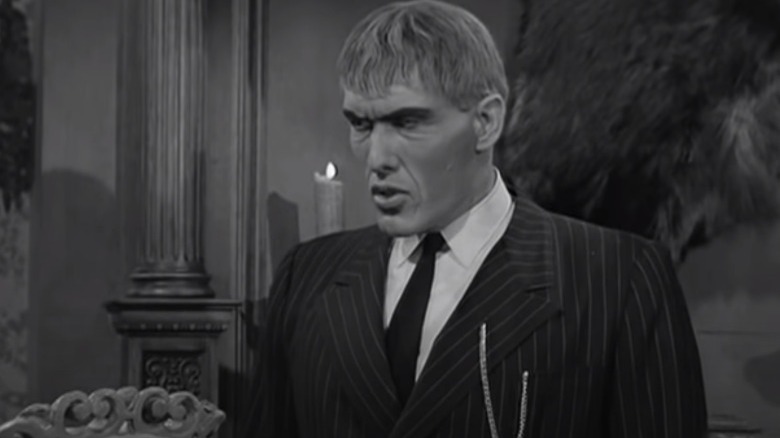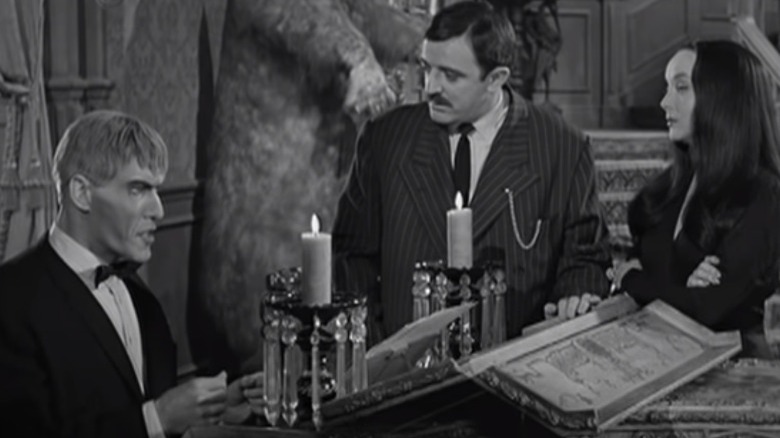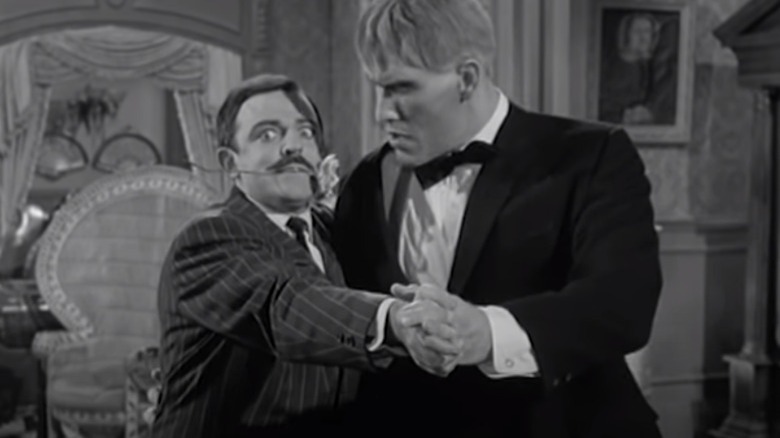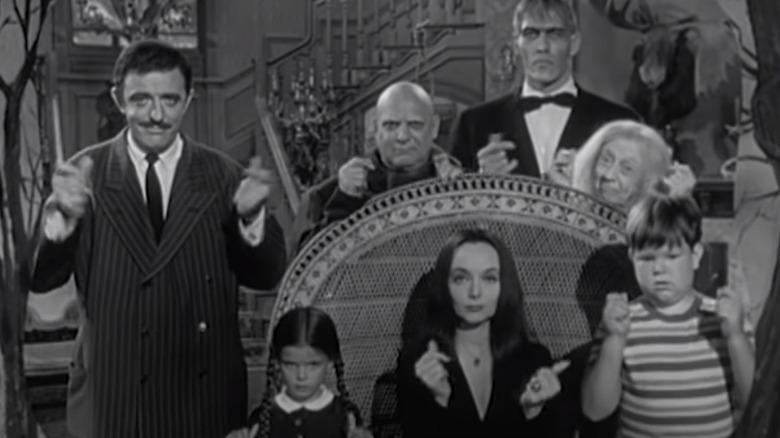The Tragic Real Life Story Of Lurch From The Addams Family
It's no secret that "The Addams Family" has been one of the most enduring sitcoms of the 1960s: Fast forward decades, and Morticia and Gomez are still some serious #relationshipgoals. Sure, they're meant to be the off-beat family that doesn't quite fit in with anyone else, but isn't that — on some level — every family? And isn't it better to march to the beat of your own drum and be happy, anyway? The idea may have been remade more than a few times, but — like so many reboots, remakes, and reinterpretations — nothing comes close to the original. That, of course, is largely because of the cast.
Towering over the rest of the family and oftentimes appearing out of nowhere — occasionally before he's even summoned — is Lurch, the family's faithful butler. The original Lurch was played by Ted Cassidy, and — fun fact — Cassidy did double duty: That's his hand portraying Thing, and according to the Smithsonian, that hand actually had a completely separate contract. Lurch may have been the most unlikely television character to kick off his own dance craze, but that's the thing about truth — it's stranger than fiction.
For all the longevity that "The Addams Family" has had, it's pretty shocking that it was originally on-air for just 2 years and 64 episodes. They packed a lot into those episodes, though, but behind the scenes, it wasn't nearly as kooky — especially for the family's Frankenstein's monster-esque butler.
He's been candid about a nightmarish childhood
It was Terry Pratchett who wrote, "It was nice to hear the voices of little children at play, provided you took care to be far enough away not to hear what they were actually saying." Anyone who's ever been one knows that children can be incredibly cruel, and when someone looks different, acts different, or stands out, then they can become a target for ridicule.
That's precisely what happened to Ted Cassidy. Although his height would help him secure the role of Lurch on "The Addams Family," he didn't always see it as a blessing. By the time he was 11 years old, he was already taller than both of his parents: His mother was 5'8", and his father 5'9". As an adult, Cassidy would later address just how hard it was growing up (via MeTV): "I even hated to go to school. I was actually ashamed of being so much bigger than the other kids. And I was awkward. At the age of 11, I was a six-footer and tripping over my own feet. I had a miserable, unhappy childhood, and wouldn't go through it again for anything in the world."
Cassidy would continue to grow, and by the time he was cast as Lurch, he had reached a height of 6'9" (via The Famous People). (For a comparison, John Astin — who played Gomez and is the real-life, adoptive father of actor Sean Astin — was 5'11".)
Ted Cassidy was open about being typecast by his appearance
Ted Cassidy was incredibly gifted: In addition to being an actor, he played the organ, played basketball, and co-wrote the screenplay for the movie based on Robert H. Rimmer's coming-of-age novel, "The Harrad Experiment." But in spite of that, he was constantly frustrated by being judged on his size and appearance. "...they always make fellows like me the big dumb galoot, the oaf who doesn't know anything, who trips over himself," he said in a 1978 interview (via The Historical Marker Database). "We are apparently idiots, all big men. ... You end up ... scratching your head a lot, wondering where all your marbles went."
For many of Cassidy's roles — from "Butch Cassidy & The Sundance Kid" to riles in "Star Trek," "The New Adventures of Huckleberry Finn," and, of course, "The Addams Family" — his characters were based around his size and a certain sort of personality. Even for voice work, he was typically cast in a certain kind of role — like The Thing in Hanna-Barbera's "The Fantastic Four." "I used to think that's how it was, and I would do it, but I won't do it anymore," he continued.
Tragically, it severely limited his opportunities, and Cassidy found himself reliant on friends and people he had worked with previously to give him a chance at other roles. Those, he said, were the only people he found "willing to put you to work so you don't end up in the welfare line."
He lived with the condition called acromegaly
According to Australia's Department of Health and Aged Care, Ted Cassidy lived with the same condition as actor Richard Kiel and wrestler Andre the Giant. It's called acromegaly, and it happens when the brain floods the body with too much of a growth hormone called somatropin. Only some of the physical complications that result from the condition are easy to see, and include — in addition to above-average height — larger-than-average hands, facial features, and feet. Acromegaly also comes with hidden complications, like high blood pressure, heart disease, and arthritis — the latter of which may have played a part in creating Lurch.
In "Making the Monster: The Science Behind Mary Shelley's Frankenstein," chemist and science communicator Kathryn Harkup says that many of the actors hired to play characters inspired by or reminiscent of Frankenstein's monsters have acromegaly: She adds that Lurch's stumbling, awkward walk is likely a result of the arthritis Cassidy would have lived with as a result of the condition.
Physical complications are only a part of the story, though. In 2022, The Milpitas Beat covered an event that was the largest gathering ever of people diagnosed with acromegaly. Attendees explained that as their bones continue to grow in diameter, the condition can take an emotional and psychological toll, too. Jill Sisco, the president of the Acromegaly Community, explained: "When you look in the mirror and don't recognize what's looking back at you, you don't want to go into public, you don't want people to see you. It's a very isolating disease."
Ted Cassidy's acting career was a midlife reboot that didn't go as planned
Ted Cassidy didn't give many interviews, but when he did, he was outspoken on how disappointed he was in the way his career had turned out. In a 1978 interview (via The Historical Marker Database), he explained, "You end up never leading anyone to anything. You end up holding people, while the boss hits them in the face." Cassidy's acting career was actually something of a midlife reboot, and seemingly, it was an attempt at finding something that made him happy. According to MeTV, he — perhaps predictably — played basketball throughout his college years at Stetson University, and then went semi-pro. They quoted him as saying, "It was the line of least resistance."
After college and basketball, he and his wife moved to Dallas. It was 1956, and he put his deep, distinctive voice to use and embarked on what would be a successful career in radio. According to CBS's retrospective on his life, he dabbled in local television alongside hosting his popular radio show on WFAA. He wasn't, they stress, just a voice who introduced songs, he was a reporter, too: He was on-site for the assassination of JFK, and interviewed some of the witnesses.
Ultimately, it was his size that made him consider a move to show business: "I figured there couldn't be too many 6'9" people in Hollywood," he once explained. Sadly, while his height did open doors, it ended up turning his career into something he resented.
His marriage ended in divorce
Long before he spent his days — half an hour at a time — caring for the Addams Family, Ted Cassidy had started a family of his own. According to MeTV, it should have been a storybook romance, and while it may have started out that way, it didn't end that way.
Cassidy was in college studying speech and drama when he met a psychology student named Margaret Helen Jesse. They married in 1956 (via the Pennsylvania Center for the Book), bought a house in Dallas, and welcomed two children — Sean in 1957, and daughter Cameron in 1960.
It was there that he started his career in broadcasting, and it was going well. The acting bug bit, and they decided to make the leap: They traded their Dallas home for a tiny, two-bedroom Hollywood apartment, and after the first year of success for "The Addams Family," they bought a California home. While his sitcom ended, Cassidy continued to work — and in 1975, the one-time storybook romance ended in divorce.
Did Ted Cassidy come to terms with Lurch?
When Ted Cassidy headed to Hollywood, he had already made a demo tape that included him performing the play "Long Day's Journey into Night." He may have been prepared, but he definitely didn't get handed the part immediately, though. The ultimate casting decision for Lurch put him up against five others — including, says MeTV, John Astin, who would ultimately be cast as Gomez.
According to Closer Weekly, it wasn't long before Cassidy started to get a bad feeling about his role as Lurch. He explained in an interview in 1970: "It was terrific until the second year, then I began to see that playing that guy, who really didn't do anything besides this schtick, was no fun. I began to react badly, not to the cast, the producer, or the director — because they were good folk — but to myself."
He knew, he said, that it was ruining his career. Did he ever come to terms with what would be his most famous role? That's debatable: In an undated, 1970s-era interview with Don Pietro, he's asked about his rise to fame as Lurch, and how he feels about being known as the steadfast butler. He responded — with a despondent sigh — "That's what everybody remembers. ... Whether I like it or not."
Interactions with fans weren't always the best
Celebrities are judged on how they interact with fans. Take Dwayne Johnson. He wasn't always the Make-A-Wish guy who once arranged to surprise a family attending one of his premieres with a new puppy — that, he's said (via CinemaBlend), was a conscious decision he made after he realized how terrible he made a couple feel after they excitedly approached him.
It's not that simple for everyone, though. Although Ted Cassidy wore quite a bit of makeup as Lurch, he was still instantly recognizable. That doesn't mean he liked it, and he's spoken about just how uncomfortable he was meeting fans — for a heartbreaking reason. "I can see it in their eyes that they think I'm dim-witted and sluggish," he once said in an interview (via MeTV). "They look at me as if I were a circus giant and talk to me in condescending tones." He was honest about how it made him feel, saying fan interactions automatically put him on the defensive, and acknowledging that he wasn't always the nicest to people who approached him. And honestly? That's completely and totally understandable.
Fortunately, though, his children had no such problems with how they saw him. They were, of course, allowed to watch the family-friendly "Addams Family" from the beginning, and Cassidy has said that even when they were young, they never had any trouble distinguishing between the character and their father.
The cast didn't get residuals
It wasn't until Desi Arnaz realized that they could rebroadcast old episodes of "I Love Lucy" and make more money off syndication rights that reruns became a thing. For a long time, it was the program's owner who benefited, not the cast.
According to the Smithsonian, most of the staying power of "The Addams Family" has been in syndication: They say that in 1991, it was still being shown in 30 different markets — that's not bad for a 30-year-old show. But instead of making them at least comfortably wealthy, Ted Cassidy and his fellow cast members didn't benefit — at all.
It was John Astin who did an interview with TV Guide (via "Monster Mash: The Creepy, Kooky Monster Craze In America, 1957-1972"). In addition to acknowledging that Cassidy and Carolyn Jones (Morticia) had worked much, much harder than he had — in large part because of their makeup and costuming — Astin confirmed that although the show had played continuously since it first aired, they had gotten nothing in terms of residuals. He had come to terms with it by taking comfort in the fact that they were still spreading the message that as odd as a family or person might look on the outside, that didn't mean they weren't good and kind on the inside. But still — a cut of the profits would have only been fair.
Ted Cassidy died very, very young
Acromegaly is treated in a variety of ways today, including surgery to remove the tumor that's causing the release of growth hormone, or medications to either shrink the tumor or stabilize the levels of hormones. According to The Cleveland Clinic, it's sometimes even curable, but in some cases, it still results in a life expectancy reduced by about 10 years.
In 1979, Ted Cassidy underwent open-heart surgery to remove a nonmalignant tumor. According to The New York Times, complications following the surgery led to his death at the young age of 46.
When John Astin did an interview with TV Guide (via "Monster Mash: The Creepy, Kooky Monster Craze In America, 1957-1972"), he lauded Cassidy's many talents — including his singing voice, and ability to play the trumpet and piano. He revealed, too, that they had remained good friends even after filming on "The Addams Family had come to an end. Astin had remained friends with Cassidy's family as well, and after he slipped into a coma post-surgery, his children had called Astin and asked him to come visit in the hopes that the sound of his voice might wake him up. Astin went — on the night before Cassidy passed away.
His costars suffered through their own horrible tragedies
There are a lot of television shows and movies that seem to come with a curse: "The Little Rascals," for instance, are often named as one, because of the tragic lives — and sometimes deaths — that the children faced as adults. It's surprising that "The Addams Family" isn't listed among the cursed more often.
In addition to the death of Ted Cassidy, Entertainment Weekly says that other cast members suffered tragic fates, too. Carolyn Jones — who played Morticia Adams — died at the also young age of 54 after being diagnosed with cancer. Jackie Coogan (Uncle Fester) died after suffering a heart attack a year after Jones's death: It was 1984, and he was 69 years old.
Ken Weatherwax — Pugsley — also died young. He passed away in 2014 after suffering a heart attack, at the age of 59. As of 2022, only two original cast members are still alive: John Astin (Gomez) and Lisa Loring (Wednesday).
